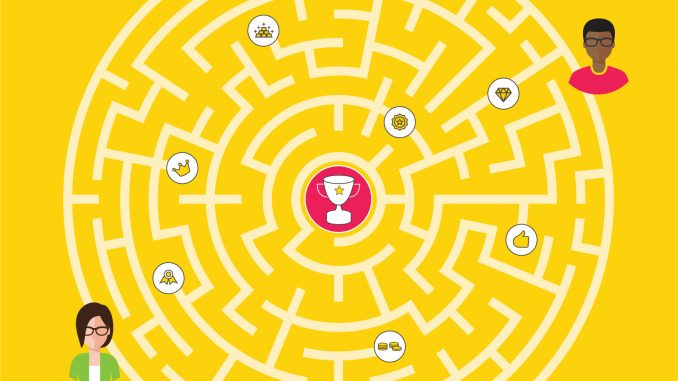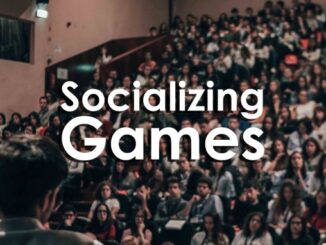
What gets you out of bed in the morning? Screaming toddlers don’t count, I’m talking about the essential you. What’s the intrinsic need, the raison d’etre, that moves you to get up, get out and give the day everything you’ve got?
Most people don’t know, or haven’t thought about it, which is why it’s a regular topic of pop psych self-improvement tests. And fair enough, the answer is an important bit of self-knowledge. To a gamification designer, it’s a design-critical piece of information to determine corresponding player types and the motivational drivers that guide effective solution design.
Good gamification design
As a quick review, good gamification design is first and foremost human-focused and ticks 5 main boxes:
- Be clear on the results you want to achieve
- Create solid metrics with specific behaviours linking back to targeted results
- Get a complete picture of the people you’re designing for
- Understand how your people fit key player types, the emotional drivers at play and the circumstances that influence motivation
- Create and retain strong user/player engagement with your system
The mysteries of motivation
If motivation were an app we’d all be high achievers, but it’s one of those self-generated (or intrinsic) states that emerges from a deep well of individual need. It can’t be bought or coaxed into long-term service with extrinsic rewards.
Psychologist David McClelland, a pioneer of workplace motivation, contends that all human motivation is underpinned by three needs: achievement, power and affiliation.
Individuals have a dominant trait, of course, but all three come into play according to stimulus and circumstance. Sounds like a job for gamification.
Need for achievement (N-Ach)

First proposed by Henry Murray and later popularised by McClelland, the Need for achievement (N-Ach) is characterised by a desire for significant accomplishment, mastery, or high standards.
People with dominant achievement needs bring the biggest overall benefit to the organisational party. Provided, of course, their need to achieve is activated, their behaviour is supported and their achievements are recognised. Gamification does all of that.
Characteristics of achievement-motivated people
- Achievement is more important (and satisfying) than material reward or recognition
- Financial reward is seen as a measurement of success, not an end in itself
- Reliable, factual feedback, is essential. Again, because it’s a solid measurement of success, rather than a generic accolade
- Security and status are secondary to achievement
- N-Ach types are constantly looking for ways to improve ways of working
Activating the Achiever with gamification
In gamification parlance, Achievers are the player equivalent of N-Ach type individuals.
Achievers want to succeed. They need to be able to see themselves moving up the ranks and to seek out challenging solutions. Each level has to be more difficult than the next, allowing the Achiever to feel a sense of accomplishment once the level is complete. The challenge continues forever and there needs to be a greater good to what this user is achieving (a new skill unlocked).
Bear in mind that there’s an ebb and flow to all three main motivators. Under the right conditions, Achievement behaviours can be awakened in dominant Power or Affiliation types with artful use of gamification mechanics.
Active ingredients
Gamification mechanics are basic actions or mechanisms employed to move activity forward. There are 10 key mechanics that ping the specific intrinsic and extrinsic needs of each player type.
- Fast feedback. Notices and messages support the intrinsic need for mastery and progress. Achievers thrive on it in pursuit of new learning and personal development.
- Transparency. Statistics and scores are intrinsic motivators meeting the need for tracking progress and comparing to others through social interaction.
- Goals. Pursuit of defined goals is intrinsically motivating. Missions, quests, challenges serve the needs for purpose, progress and social interaction.
- Badges. A public symbol of accomplishment, successful conquest or high achievement, speaking to the needs for mastery, progress, purpose and social interaction.
- Levelling up. The gamification equivalent of climbing the corporate ladder. Levelling up is a long-term effort and sign of status. It meets intrinsic needs for mastery, progress, purpose and social interaction.
- Onboarding. Guiding learning within the context of broader gamification design. Onboarding moves new participants through a series of progressively harder exercises until skills are acquired. In other words, training without training. It supports the intrinsic need for mastery.
- Competition. Not necessarily applicable to every gamification design, leaderboards, are popular mechanics meeting intrinsic needs for mastery and social interaction.
- Collaboration. In the form of teams, collaborative effort meets intrinsic needs for purpose and social interaction and supports networking, culture and knowledge sharing.
- Community. A critical success factor in long-term gamification systems, community supports the basic human need for sharing, comparing, and social interactions.
- Points. An intrinsic motivator supporting progress and social interaction, points indicate progress, potential reward and evidence of accomplishment.
Source: Rajat Paharia, Loyalty 3.0, p 73
Achievement, power, affiliation
Individual motivation is a private blend of universal human needs. Good gamification design combines the right active ingredients, in the right order, to create a dynamic, personally satisfying solution.
- Hunger gamification - 11th March 2020





Be the first to comment